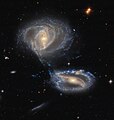File:A dynamic duo or trio - potw2343a.jpg

Original file (1,280 × 1,347 pixels, file size: 276 KB, MIME type: image/jpeg)
Captions
Captions
Summary
[edit]| DescriptionA dynamic duo or trio - potw2343a.jpg |
English: This striking image captures the interacting galaxy pair known as Arp-Madore 2339-661, so named because they belong to the Arp-Madore catalogue of peculiar galaxies. However, this particular peculiarity might be even odder than first meets the eye, as there are in fact three galaxies interacting here, not just two. The two clearly defined galaxies are NGC 7733 (smaller, lower right) and NGC 7734 (larger, upper left). The third galaxy is currently referred to as NGC 7733N, and can actually be spotted in this picture if you look carefully at the upper arm of NGC 7733, where there is a visually notable knot-like structure, glowing with a different colour to the arm and obscured by dark dust. This could easily pass as part of NGC 7733, but analysis of the velocities (speed, but also considering direction) involved in the galaxy shows that this knot has a considerable additional redshift, meaning that it is very likely its own entity and not part of NGC 7733. This is actually one of the many challenges that observational astronomers face: working out whether an astronomical object really is just one, or one lying in front of another as seen from Earth’s perspective! All three galaxies lie quite close to each other, roughly 500 million light-years from Earth in the constellation Tucana, and, as this image shows, they are interacting gravitationally with one another. In fact, some science literature refers to them as a ‘merging group’, meaning that they are on a course to ultimately becomea single entity. [Image Description: Two spiral galaxies. Each glows brightly in the centre, where a bar stretches from side to side. The upper one is more round and its arms form two thin rings. The lower galaxy is flatter and its arms make one outer ring; a dusty knot atop its upper arm marks outa third object. Gravity is pulling gas and dust together where the galaxies come close. A number of small galaxies surround them on a black background.] Links Pan: A dynamic duo … or trio? |
| Date | |
| Source | https://esahubble.org/images/potw2343a/ |
| Author |
ESA/Hubble & NASA, J. Dalcanton, Dark Energy Survey/DOE/FNAL/NOIRLab/NSF/AURA Acknowledgement: L. Shatz |
Licensing
[edit]| ESA/Hubble images, videos and web texts are released by the ESA under the Creative Commons Attribution 4.0 International license and may on a non-exclusive basis be reproduced without fee provided they are clearly and visibly credited. Detailed conditions are below; see the ESA copyright statement for full information. For images created by NASA or on the hubblesite.org website, or for ESA/Hubble images on the esahubble.org site before 2009, use the {{PD-Hubble}} tag.
Conditions:
Notes:
|
- You are free:
- to share – to copy, distribute and transmit the work
- to remix – to adapt the work
- Under the following conditions:
- attribution – You must give appropriate credit, provide a link to the license, and indicate if changes were made. You may do so in any reasonable manner, but not in any way that suggests the licensor endorses you or your use.
File history
Click on a date/time to view the file as it appeared at that time.
| Date/Time | Thumbnail | Dimensions | User | Comment | |
|---|---|---|---|---|---|
| current | 02:29, 19 January 2024 |  | 1,280 × 1,347 (276 KB) | Laensom (talk | contribs) | Uploaded a work by ESA/Hubble & NASA, J. Dalcanton, Dark Energy Survey/DOE/FNAL/NOIRLab/NSF/AURA Acknowledgement: L. Shatz from https://esahubble.org/images/potw2343a/ with UploadWizard |
You cannot overwrite this file.
File usage on Commons
There are no pages that use this file.
Metadata
This file contains additional information such as Exif metadata which may have been added by the digital camera, scanner, or software program used to create or digitize it. If the file has been modified from its original state, some details such as the timestamp may not fully reflect those of the original file. The timestamp is only as accurate as the clock in the camera, and it may be completely wrong.
| Source | ESA/Hubble |
|---|---|
| Credit/Provider | ESA/Hubble & NASA, J. Dalcanton, Dark Energy Survey/DOE/FNAL/NOIRLab/NSF/AURAAcknowledgement: L. Shatz |
| Short title |
|
| Image title |
|
| Usage terms |
|
| Date and time of data generation | 06:00, 23 October 2023 |
| Software used | Adobe Photoshop 24.4 (Windows) |
| File change date and time | 01:12, 4 October 2023 |
| Date and time of digitizing | 12:41, 21 June 2022 |
| Date metadata was last modified | 03:12, 4 October 2023 |
| Unique ID of original document | xmp.did:14d2b815-7495-674b-aa1e-4b874cbc55af |
| Keywords |
|
| Contact information |
ESA Office, Space Telescope Science Institute, 3700 San Martin Dr Baltimore, MD, 21218 United States |
| IIM version | 4 |

.jpg/64px-Hubble_Space_Telescope_(27946391011).jpg)